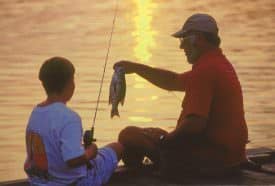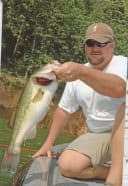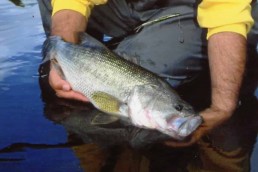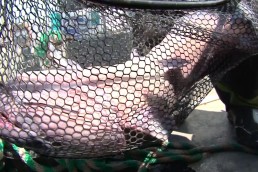Properly Releasing Caught Fish
SHARE THIS POST
Catch and release. Some anglers swear by it; others swear at it. When sport fishing-activity is high, the angling demand on many rivers and lakes cannot match a body of water’s ability alone to produce fish for all. For that reason, many waterways have catch-and-release regulations to promote a quality fishery. The caveat is catch-and-release only works if a fish survives catch-and-release.
The concept behind this kind of fishing is that by releasing fish caught via sporting means, those same fish will continue to breed and provide food for other species, as well as staying available for future anglers. Catch-and-release fishing enables fishermen to pursue the activity without depleting the resource.
History
The idea behind catch-and-release has a long history. First used by the British in the nineteenth century, catch and release of fish was developed originally to deal with the loss of fish habitats. Many animal species were becoming extinct and it was recognized that something needed to be done. Preservation of a species, particularly trout, became paramount in Britain.
Anglers in this country began practicing it in Michigan, in 1952. So-called “No-Kill” zones were set up around the state to preserve fish populations.

Today, most American states have laws aimed at protecting various fish species. Some fish have been caught and released as many as 30 times. This high recapture rate reinforces the positive application of catch-and-release.
General considerations
Avoid fishing during times of extreme temperatures. These waters physiologically stress fish, making it more likely they will die after being released. Do not leave fishing lines unattended too. Fish are more likely to get deep-hooked on unattended lines, thereby increasing the mortality risk.
Always strive to keep fish in the water. Even a few seconds out of water can make a difference. A third of the fish will die if exposed to air for 30 seconds after struggling on a fishing line. Don’t use a net while landing a fish. Nets can damage fish scales and the protective slime layer that fish need to survive. Baitfishing is popular with many anglers, however a baited hook is often swallowed, leading to a hook becoming deeply embedded in their stomachs. To reduce “gut-hooking,” anglers should use artificial lures or try and set the hook immediately, before the bait is swallowed. When bait is swallowed, cut the line as close to the hook eye as possible to prevent damage to a fish’s internal organs, which can occur while removing the hook.
Your catch-and-release needs improving if your fish bleed from the mouth or gills as a result of hook removal. Again, survival is reduced significantly when damage to the gills occurs. If regulations allow, fish that bleed should be kept and eaten.
To be a conscientious fisherman, ask yourself: Can I safely bring a fish to me and release it from an embankment that is 10 feet above the water? If you are serious about fish survival, consider fishing from a spot that allows you to land and release any fish quickly and gently.
Successful catch and release starts with the choices you make in fishing tackle. Use circle hooks, which are swallowed less frequently than traditional hooks, helping to prevent internal injuries. You also want to hook a fish by setting a circle hook in the corner of its mouth.
Never tear a hook out
Such action will likely harm a fish. If it is hooked deeply and you can’t remove it easily, consider making that fish part of your daily catch. When the line is cut, the fish may swim away, however many may die within hours.
Playing a fish
By its very nature, the lure of sport angling involves the thrill of fighting a fish. While this practice is exhilarating, it can be devastating to a fish. Playing a fish to the point of its exhaustion contributes dramatically to mortality rates. Fish should be brought in using a slow, steady retrieve.
If you must remove a fish from the water, keep its “air time” to a minimum. Some fish species can suffer gill desiccation (drying) in as little as 20 seconds. The more damage to its gill tissue, the greater likelihood it will die.
Bass may experience “barotrauma” when they are brought up from deep waters. Barotrauma results from the expansion of gases in the swim bladder when fish do not have the time to adjust to rapid changes in water pressure as they are pulled toward the surface.
Are you enjoying this post?
You can be among the first to get the latest info on where to go, what to use and how to use it!
Try to revive a fish before releasing it. Recharging a tired fish is usually as simple as cradling the fish in the water and allowing it to catch its breath. In a river system, it is important to face the fish into the current. If no current is available, gently move the fish back and forth, thereby forcing oxygenated water through its gills.
Is catch and release harmless?|
There is talk in some fishing circles that this practice isn’t as benign as once thought, that the released fish behave erratically or die soon after being caught. If true, this throws the whole matter of into question.
Why release fish at all if they’re going to die? Is it primarily done to help an angler feel better?

Some people think so. They say they’ve seen dead fish floating in the water with indications they had recently been caught and released, or, they’ve seen released fish behaving strangely, such as failing to spawn.
A personal commitment to conservation adds to the enjoyment of fishing. But there is a big difference between “simple” catch-and-release and “proper” catch-and-release. Some fishermen consider grabbing a bass mid-body, nearly squeezing its guts out, ripping the hook free and then tossing the fish back in the water as catch-and-release. An informed angler knows that the end result of a sloppy release is, more likely than not, the death of the fish he or she wants to preserve. Mortality rates of released fish drop dramatically when anglers follow a few guidelines.
A few simple steps should be followed when catching and releasing a fish. Once you understand how to do it correctly, you will be able to enjoy your pastime and keep the population of fish fairly stable in favorite streams and lakes.
Questions and answers regarding catch and release:
1). How long can a fish be out of water before damage occurs?
Five minutes max.
2). How long does it take for a fish in a bag to run out of air?
Almost immediately.
3). What is the “best” way to transport fish in the boat for the weigh-in?
There is no best method. Weigh the fish you have caught within five minutes or it will likely die.
All fish deserve our respect, regardless of species. Every kind is part of the ecosystem in which they live, and all can provide us with a battle when caught. The fish merit our respect, whether we selectively harvest or catch-and-release them in the hopes that they will fight again.
MWO
SHARE THIS POST
Did you enjoy this post?
You can be among the first to get the latest info on where to go, what to use and how to use it!
Joe Zentner
Joe Zentner has caught and released fish from the Midwest to the Atlantic Coast. His articles have appeared in a variety of publications.



